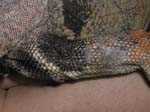

IMPORTANT: These pages on health are meant to be general guides, not hard and fast rules. They were not written by vets and are NO SUBSTITUTE for veterinary care. If you suspect something is wrong with your iguana, PLEASE see a qualified veterinarian!
Mite Eradication
Mites are the bane of all reptile keepers. Mites being a close relative to the Tick and the Flea, they can be difficult to kill and totally wreak havoc among reptiles.
The mite's life cycle is fairly straightforward. They hatch, find a prey item (the reptile), feed and then lay more eggs before they die.
So why are they so hard to kill? Simply because we often fail to kill all of them or reach the hiding spots where they are known to lay their eggs. Unlike some parasites, reptiles can not live in peace with these pests because for the mite to eat it needs to burrow its jaws into the reptile's flesh and drinks its blood. Often these mites will leave behind nasty wounds and scars as well as infection. With a large mite infestation, your reptile may also become anemic.
The easiest way to describe a mite infestation is to imagine an animal covered with what looks to be poppy seeds. Little black specks all over the place. Unfortunately these black spots are mature mites that have already had a feast on your pet's blood. The best way to keep this from getting to this stage is to look for the babies during every cage cleaning. Baby mites are often hard to see but if you look closely at the eyes of a reptile you may just be lucky enough to see one run past it. This chance is greatly increased with the aid of a magnifying glass. You can easily rub your finger around the eye lids as this will disturb the mites and they will run. Young mites will look like little red moving dots.
You should remember that mites are easiest to find in the eyes since they often hide within the eye sockets. However the mites will live and feed all over your reptile's body. The only time that a mite will leave its host will be to lay its eggs.
Mites will notoriously lay their eggs on the enclosure walls, floors, roofs and just about anywhere but on the prey. This fact is probably the number one reason that we often become re-infested time after time.
In past years reptile keepers have tried many different ways to kill mites. Unfortunately many of the commercial products found to kill mites either do not work or are toxic to the pet itself. At other times plain bathing has been used but often with poor results. Veterinarians will at times use an injectable drug called Ivermectin which is supposed to go into the blood stream and then dehydrate and kill the mites as the mites drink it. However this is often known to fail.
Several years ago I was told of a procedure to rid a reptile of mites completely in one session. I would normally question this but it was backed and tested by N.O.A.H., the North Ohio Association for Herpetology. The procedure has been used in the Iguana Den several times and has worked so successfully that I would be hard pressed to try any other.
You need to buy either NIX or RID Head Lice Shampoo at your local shopping store. Mixing one of these product in a 1 to 1 ratio with water your are ready to proceed. I prefer to use 1 cap full of water to 1 cap full of Nix. Pour this mixture into your hands and rub down the reptile from nose to tail. Do not worry about getting this into the eyes as it has been found to be very safe on all reptiles. Be sure to pay attention to the folds under the neck as well as the arms on lizards. Wait 10 minutes and rinse well. Be sure to rinse the animal until all of the mixture is off. Since Rid and Nix are known to kill the eggs of Lice it has been found to be just as successful with mites.
There are also two commercial products on the market, Provent A Mite and Black Knight, that seem to do a good job of safely eradicating mites from enclosures and rooms. It is not recommended that either of these be used directly on your iguana! Instead, use these to eradicate mites from the environment after removing them from your iguana.
These methods are truly worthless however unless you thoroughly clean and disinfect your cage. On glass cages this is easily accomplished with a strong bleach and water solution. You can either fill the tank completely with water and bleach or attempt to just wipe it down. However since mites will often lay their eggs in the crevices that are hard to reach I recommend filling the tank completely if at all possible. All branches should be destroyed and water and food bowls disinfected with the same bleach and water solution.
In larger enclosures made of other materials such as wood and Plexiglas I find a much easier method of BOMBING to work well. You will need to use large garbage bags that have been cut open in order to seal the cage completely. Tape the bags over the enclosure in order to make it air tight. Before you tape off that final flap you can place a FLEA and TICK BOMB found in most stores within the enclosure. Press the button and lock it in place. Tape off the last flap and relax and enjoy the company of your pet for the next few hours. You can open the cage back up within 2 hours. Be sure to air it out completely. Wipe down the cage and sterilize completely before returning your pet into it's home.
While these methods work very well, I always recommend a follow up treatment within 3-5 days on both the reptile and the cage. This way any mite eggs that were not removed with the original cleaning and that are beginning to hatch will be completely eradicated.
Mite
Scars |
| Click
on thumbnail for larger picture. |
Search |
